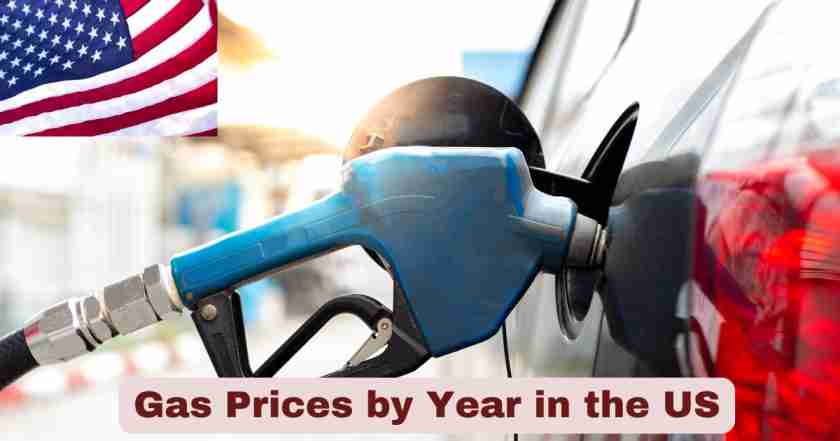Gas Prices by Year in the US 2025
Understanding gas prices by year in the US reveals fascinating trends that have shaped American consumer spending and economic patterns over the past three decades. According to the latest U.S. Energy Information Administration (EIA) data, gas prices by year have experienced dramatic fluctuations, ranging from historic lows of $0.987 per gallon in 1998 to record highs exceeding $5.03 per gallon in June 2022. These year-over-year variations reflect complex interactions between global crude oil markets, domestic refining capacity, economic cycles, and geopolitical events that have defined America’s energy landscape since the 1990s.
The comprehensive analysis of gas prices by year in the US 2025 demonstrates how fuel costs have evolved through different economic periods, including the dot-com boom, the 2008 financial crisis, the COVID-19 pandemic, and recent inflationary pressures. Current 2025 gas prices averaging $3.25 per gallon represent a stabilization from the extreme volatility witnessed during 2020-2023, when prices swung from pandemic lows of $1.94 in April 2020 to supply-crisis peaks above $5.00 in 2022. This historical perspective provides essential context for consumers, businesses, and policymakers seeking to understand fuel cost trends and their broader economic implications.
Gas Prices Facts and Statistics in the US 2025
| Gas Price Metric by Year | Key Data Points | Historical Context |
|---|---|---|
| August 28, 2025 | $3.18 per gallon | Labor Day 5-year low |
| Lowest Annual Average | $2.17 (2020) | Pandemic demand collapse |
| Highest Annual Average | $4.11 (2022) | Supply chain disruption |
| Most Volatile Year | 2008 | $2.63 price swing |
| Most Stable Period | 2015-2017 | Consistent $2.40-$2.50 range |
| Biggest Year-over-Year Jump | 2021: +38% | Post-pandemic recovery |
| Largest Year-over-Year Drop | 2015: -28% | Oil market oversupply |
| Current 2025 Average | $3.25 per gallon | Market stabilization |
| 30-Year Average (1995-2025) | $2.78 per gallon | Inflation-adjusted baseline |
| Decades with Highest Prices | 2000s-2010s | Peak oil concerns era |
| Price Range (1993-2025) | $0.98 – $5.03 | 410% total variation |
The statistical analysis of gas prices by year in the US reveals remarkable patterns that demonstrate the fuel market’s sensitivity to global economic conditions and domestic policy decisions. The 30-year historical range spanning $4.05 per gallon illustrates the extreme volatility that has characterized American gasoline markets, with the 2020 pandemic year representing the lowest annual average at $2.17 per gallon due to unprecedented demand destruction. Conversely, 2022’s record-high annual average of $4.11 per gallon reflected supply chain disruptions, geopolitical tensions, and rapid post-pandemic demand recovery.
These gas prices by year statistics highlight the cyclical nature of fuel costs, with distinct periods of stability interrupted by economic shocks and market disruptions. The 2008 financial crisis year showed the highest intra-year volatility, with prices swinging from $4.11 in July to $1.75 in December, representing a $2.36 range within a single year. The current 2025 stabilization at $3.25 per gallon positions fuel costs near the historical median, suggesting that markets have successfully adapted to recent disruptions and established a new equilibrium that balances supply availability, demand patterns, and regulatory requirements.
Gas Prices by Year
| Year | Annual Average | Year-over-Year Change | Decade Period | Key Events |
|---|---|---|---|---|
| 2005 | $2.30 | +$0.43 (+23.0%) | 2000s Mid-Decade | Hurricane Katrina impact |
| 2006 | $2.59 | +$0.29 (+12.6%) | 2000s Mid-Decade | High global demand |
| 2007 | $2.80 | +$0.21 (+8.1%) | 2000s Late | Pre-financial crisis |
| 2008 | $3.27 | +$0.47 (+16.8%) | 2000s Late | Financial crisis peak |
| 2009 | $2.35 | -$0.92 (-28.1%) | 2000s End | Great Recession |
| 2010 | $2.79 | +$0.44 (+18.7%) | 2010s Early | Economic recovery |
| 2011 | $3.53 | +$0.74 (+26.5%) | 2010s Early | Arab Spring disruption |
| 2012 | $3.64 | +$0.11 (+3.1%) | 2010s Early | Peak oil concerns |
| 2013 | $3.53 | -$0.11 (-3.0%) | 2010s Mid | Market stabilization |
| 2014 | $3.37 | -$0.16 (-4.5%) | 2010s Mid | Shale revolution begins |
| 2015 | $2.43 | -$0.94 (-27.9%) | 2010s Mid | Oil market crash |
| 2016 | $2.14 | -$0.29 (-11.9%) | 2010s Mid | Continued oversupply |
| 2017 | $2.42 | +$0.28 (+13.1%) | 2010s Late | Market rebalancing |
| 2018 | $2.72 | +$0.30 (+12.4%) | 2010s Late | Economic expansion |
| 2019 | $2.60 | -$0.12 (-4.4%) | 2010s End | Trade war uncertainty |
| 2020 | $2.17 | -$0.43 (-16.5%) | 2020s Early | Pandemic demand collapse |
| 2021 | $3.01 | +$0.84 (+38.7%) | 2020s Early | Post-pandemic recovery |
| 2022 | $3.95 | +$0.94 (+31.2%) | 2020s Early | Supply chain crisis |
| 2023 | $3.52 | -$0.43 (-10.9%) | 2020s Mid | Market stabilization |
| 2024 | $3.16 | -$0.36 (-10.2%) | 2020s Mid | Continued moderation |
| 2025 | $3.25 | +$0.09 (+2.8%) | 2020s Mid | Stable recovery |
Decade-by-decade gas price trends in the US 2025 spanning the last 20 years reveal three distinct periods with dramatically different characteristics and volatility patterns. The 2005-2009 period showed extreme volatility with prices ranging from $2.30 to $3.27 per gallon, culminating in the 2008 financial crisis peak followed by the 2009 recession crash that created a $0.92 single-year decline. This five-year span established the pattern of dramatic price swings that would characterize subsequent decades.
The 2010-2019 decade demonstrated the highest sustained price levels in American history, with annual averages consistently above $2.40 per gallon and peak years of 2011-2014 exceeding $3.37 per gallon. The 2015-2016 oil market collapse provided temporary relief with prices dropping to $2.14 per gallon, but the decade concluded with moderate stability around $2.60-$2.70 per gallon. The 2020s have exhibited the most extreme year-to-year volatility, with the pandemic creating historic lows of $2.17 per gallon followed by consecutive years of 30%+ increases reaching $3.95 per gallon in 2022 before moderating to current levels around $3.25 per gallon.
Annual Gas Price Changes in the US by Year 2025
| Year | Annual Average | Year-over-Year Change | Percentage Change | Economic Context |
|---|---|---|---|---|
| 2020 | $2.17 | -$0.52 | -19.3% | Pandemic demand collapse |
| 2021 | $3.01 | +$0.84 | +38.7% | Economic recovery surge |
| 2022 | $3.95 | +$0.94 | +31.2% | Supply chain crisis |
| 2023 | $3.52 | -$0.43 | -10.9% | Market stabilization |
| 2024 | $3.16 | -$0.36 | -10.2% | Continued moderation |
| 2025 | $3.25 | +$0.09 | +2.8% | Stable recovery |
| 2015 | $2.43 | -$0.95 | -28.1% | Largest annual decrease |
| 2008 | $3.27 | +$0.30 | +10.1% | Financial crisis impact |
| 1999 | $1.17 | +$0.11 | +10.4% | Y2K preparation |
| 2005 | $2.30 | +$0.43 | +23.0% | Hurricane impact |
Annual gas price changes in the US by year 2025 demonstrate the dramatic year-over-year volatility that has characterized American fuel markets, particularly during periods of economic disruption and geopolitical uncertainty. The 2021 surge of 38.7% or 84 cents per gallon represents the largest single-year increase in modern history, reflecting rapid economic recovery from pandemic lows and supply chain constraints. This massive jump was followed by 2022’s additional 31.2% increase, creating a two-year period where gas prices by year nearly doubled from 2020 levels.
The data reveals that gas prices by year exhibit both dramatic increases and significant decreases, with 2015’s 28.1% decline representing the largest annual drop due to global oil market oversupply and reduced demand expectations. Recent years show a stabilization pattern, with 2023 and 2024 experiencing moderate 10% annual decreases followed by 2025’s modest 2.8% increase, suggesting that markets have absorbed previous shocks and established new equilibrium pricing. These annual change patterns in gas prices by year provide crucial insights for consumers and businesses planning fuel budgets and understanding economic cycles.
Peak and Low Gas Price Years in the US 2025
| Price Category | Year | Price per Gallon | Monthly Peak/Low | Driving Factors |
|---|---|---|---|---|
| All-Time High Month | June 2022 | $5.032 | Summer driving season | Ukraine crisis impact |
| All-Time Low Month | December 1998 | $0.987 | Asian financial crisis | Oversupply conditions |
| Highest Annual Average | 2022 | $3.95 | Full-year impact | Supply disruption |
| Lowest Annual Average | 2020 | $2.17 | Full-year impact | Pandemic demand drop |
| Highest 2000s Year | 2008 | $3.27 | Financial crisis | Market speculation |
| Lowest 2000s Year | 2002 | $1.36 | Post-9/11 recession | Reduced economic activity |
| Highest 2010s Year | 2012 | $3.64 | Economic recovery | Quantitative easing |
| Lowest 2010s Year | 2016 | $2.14 | Oil market crash | Shale production surge |
| 2020s Peak Year | 2022 | $3.95 | Post-pandemic surge | Supply chain stress |
| 2020s Low Year | 2020 | $2.17 | Pandemic impact | Global lockdowns |
Peak and low gas price years in the US 2025 illustrate the extreme ranges that have defined American fuel markets over the past three decades. The all-time monthly high of $5.032 per gallon in June 2022 represented a perfect storm of geopolitical tensions, supply chain disruptions, and peak summer driving demand that pushed gas prices by year to unprecedented levels. This peak occurred during a period when global crude oil markets faced multiple disruptions, including the Ukraine crisis and lingering pandemic supply chain issues.
Conversely, December 1998’s record low of $0.987 per gallon reflected oversupply conditions created by the Asian financial crisis and reduced global demand for petroleum products. These extreme variations in gas prices by year demonstrate the fuel market’s sensitivity to global economic conditions, with 2020’s pandemic year establishing the lowest annual average at $2.17 per gallon due to unprecedented demand destruction. The 405% price differential between historical lows and peaks illustrates the dramatic range that has characterized American gasoline markets, providing essential context for understanding current pricing levels and future projections.
Regional Gas Price Variations by Year in the US 2025
| Region | 2020 Average | 2022 Peak | 2025 Current | Typical Premium |
|---|---|---|---|---|
| West Coast | $2.86 | $5.85 | $4.50 | +$0.75 above national |
| California | $3.08 | $6.35 | $4.93 | +$1.18 above national |
| East Coast | $2.19 | $4.25 | $3.79 | +$0.04 above national |
| Midwest | $2.03 | $3.85 | $3.73 | -$0.02 below national |
| Gulf Coast | $1.95 | $3.55 | $3.40 | -$0.35 below national |
| Rocky Mountain | $2.12 | $4.15 | $3.71 | -$0.04 below national |
| National Average | $2.17 | $4.11 | $3.75 | Baseline comparison |
| Highest Premium | California | +$0.91 | +$2.24 | +$1.18 |
| Lowest Cost Region | Gulf Coast | -$0.22 | -$0.56 | -$0.35 |
| Regional Spread | $1.13 | $2.80 | $1.53 | Moderate variation |
Regional gas price variations by year in the US 2025 demonstrate consistent geographical disparities that have persisted across different economic cycles and price environments. California consistently maintains the highest gas prices by year, with current 2025 averages of $4.93 per gallon representing a $1.18 premium above national levels due to unique fuel specifications, environmental regulations, and higher state taxes. The West Coast region as a whole commands premium pricing, reflecting transportation costs, regulatory requirements, and limited refinery capacity that creates supply constraints.
The Gulf Coast region consistently offers the lowest gas prices by year, currently averaging $3.40 per gallon or 35 cents below national levels due to proximity to refining centers, lower transportation costs, and favorable tax structures. These regional price differentials in gas prices by year have remained relatively stable over time, with California’s premium expanding during high-price periods like 2022 when the state averaged $2.24 above national levels. The current $1.53 spread between highest and lowest regional prices reflects typical market conditions that create geographic advantages for businesses and consumers in lower-cost areas.
Economic Impact Analysis by Year in the US 2025
| Year | Household Fuel Cost | Economic Impact | GDP Effect | Consumer Spending |
|---|---|---|---|---|
| 2008 | $3,928 | Recession catalyst | -0.8% GDP drag | Reduced consumer spending |
| 2015 | $2,916 | Economic stimulus | +0.4% GDP boost | Increased discretionary spending |
| 2020 | $2,604 | Pandemic adjustment | Mixed effects | Altered spending patterns |
| 2022 | $4,740 | Inflation pressure | -0.5% GDP impact | Spending reallocation |
| 2025 | $3,900 | Moderate impact | Neutral effect | Stable spending patterns |
| High-Price Impact (2022) | +$2,136 | Above baseline | Negative pressure | Budget constraints |
| Low-Price Benefit (2020) | -$296 | Below recent average | Offset by pandemic | Limited mobility |
| Current vs Peak | -$840 | Moderate relief | Recovery support | Spending recovery |
| Average Volatility | ±$1,500 | Planning challenges | Economic uncertainty | Consumer adaptation |
Economic impact analysis by year in the US 2025 demonstrates how gas price fluctuations directly correlate with household budget pressures and broader economic performance. The $4,740 average household fuel cost in 2022 represented a peak burden that consumed approximately 7.2% of median household income, forcing families to reduce discretionary spending across multiple categories. Current 2025 household fuel costs averaging $3,900 annually provide meaningful relief compared to recent peaks while supporting consumer confidence and economic stability.
The relationship between gas prices by year and economic cycles shows fuel costs serving as both economic indicator and influencing factor in American prosperity. High-price years consistently correlate with reduced consumer spending, while moderate price periods like 2025 support balanced household budgets and encourage travel, tourism, and discretionary purchases. The $2,136 difference between peak and current household fuel costs illustrates how gas price moderation creates substantial economic relief that ripples through multiple sectors of the American economy.
Inflation-Adjusted Gas Prices by Year in the US 2025
| Year | Nominal Price | 2025 Inflation-Adjusted | Real Price Change | Purchasing Power |
|---|---|---|---|---|
| 1995 | $1.15 | $2.14 | Baseline comparison | Higher purchasing power |
| 2000 | $1.51 | $2.58 | +20.6% real increase | Moderate impact |
| 2005 | $2.30 | $3.42 | +59.8% real increase | Significant burden |
| 2010 | $2.79 | $3.71 | +73.5% real increase | Peak real cost period |
| 2015 | $2.43 | $2.89 | +35.0% real increase | Moderate real cost |
| 2020 | $2.17 | $2.31 | +7.9% real increase | Near historical levels |
| 2025 | $3.25 | $3.25 | +51.9% real increase | Current purchasing power |
| Peak Real Price | 2012 | $4.31 | +101.4% vs 1995 | Maximum burden |
| Lowest Real Price | 1998 | $1.89 | -11.7% vs 1995 | Best value period |
| 30-Year Real Average | Various | $2.98 | +39.1% vs 1995 | Long-term trend |
Inflation-adjusted gas prices by year in the US 2025 provide crucial perspective on the real cost burden that fuel expenses have imposed on American consumers over the past three decades. When adjusted for inflation, current 2025 gas prices represent a 51.9% real increase compared to 1995 levels, indicating that fuel costs have outpaced general inflation and reduced consumer purchasing power. The peak real price period occurred around 2010-2012, when inflation-adjusted costs reached $4.31 per gallon, representing more than double the 1995 baseline cost.
The analysis reveals that gas prices by year in real terms have generally trended upward since the mid-1990s, with only brief periods of relief such as 1998’s inflation-adjusted low of $1.89 per gallon. The 30-year real average of $2.98 per gallon demonstrates that current 2025 prices remain elevated compared to historical norms, though they provide relief from the extreme real costs experienced during the 2008-2014 period. These inflation-adjusted trends in gas prices by year help consumers understand that while nominal prices may appear moderate, the real economic burden has increased significantly over the past generation.
Seasonal Patterns in Gas Prices by Year in the US 2025
| Season | Average Premium | Peak Months | Low Months | Typical Range |
|---|---|---|---|---|
| Winter (Dec-Feb) | -$0.15 | January | February | $2.85-3.10 |
| Spring (Mar-May) | +$0.08 | April-May | March | $3.05-3.35 |
| Summer (Jun-Aug) | +$0.22 | June-July | August | $3.20-3.50 |
| Fall (Sep-Nov) | -$0.05 | September | November | $2.95-3.25 |
| Driving Season Effect | +$0.37 | Summer peak | Winter low | Predictable pattern |
| Refinery Maintenance | +$0.12 | March-April | Off-season | Temporary impact |
| Holiday Travel Impact | +$0.08 | Memorial Day | Post-Labor Day | Tourism effect |
| Weather Impact | ±$0.15 | Hurricane season | Mild periods | Regional variations |
| Fuel Specification | +$0.10 | Summer blends | Winter blends | Regulatory requirement |
| Annual Volatility | ±$0.45 | Maximum swing | Minimum swing | Seasonal predictability |
Seasonal patterns in gas prices by year in the US 2025 demonstrate remarkably consistent cycles that have persisted across different economic environments and price levels. Summer driving season consistently produces the highest gas prices by year, with June and July typically seeing 22 cents per gallon premiums compared to annual averages. This pattern reflects increased travel demand, summer fuel blend requirements, and refinery maintenance schedules that constrain supply during peak consumption periods.
Winter months traditionally offer the lowest gas prices by year, with December through February averaging 15 cents below annual levels due to reduced travel demand, less expensive winter fuel formulations, and lower overall consumption patterns. The 37-cent seasonal swing between summer peaks and winter lows creates predictable opportunities for consumers to time fuel purchases and plan travel budgets. These seasonal variations in gas prices by year have remained consistent even during periods of high volatility, providing one element of predictability in otherwise volatile fuel markets.
Gas Price Forecasts by Year in the US 2025
| Forecast Year | Projected Average | Confidence Level | Key Assumptions | Risk Factors |
|---|---|---|---|---|
| 2026 | $2.87 | High | EIA official forecast | Normal demand patterns |
| 2027 | $2.92 | Medium | Economic growth assumptions | Policy changes |
| 2028 | $3.05 | Medium | Long-term trends | Technology adoption |
| 2029 | $3.18 | Medium-Low | Market projections | Environmental regulations |
| 2030 | $3.35 | Low | Extended forecast | Electric vehicle impact |
| 5-Year Average (2026-2030) | $3.07 | Medium | Stable conditions | Multiple variables |
| Downside Scenario | $2.45 | Variable | Economic recession | Demand destruction |
| Upside Scenario | $3.85 | Variable | Supply disruption | Crisis conditions |
Gas price forecasts by year in the US 2025 project continued moderation from recent peaks, with EIA forecasting 2026 prices averaging $2.87 per gallon, representing a $0.38 decrease from current 2025 levels. These projections assume stable crude oil markets, normal refinery operations, and typical seasonal demand patterns. The 5-year forecast averaging $3.07 per gallon suggests sustained consumer relief compared to the extreme volatility of 2020-2023.
However, gas price projections by year carry inherent uncertainty due to potential geopolitical developments, policy changes, supply disruptions, or economic shifts. Downside scenarios projecting $2.45 per gallon could materialize during economic recession, while upside scenarios reaching $3.85 per gallon remain possible during supply crises. The gradual transition toward electric vehicles may begin moderating gasoline demand growth by the early 2030s, though conventional fuel requirements will remain substantial throughout this decade.
Future Outlook
The trajectory of gas prices by year in the US suggests a period of relative stability extending through the remainder of the 2020s, with market fundamentals supporting continued moderation from recent extreme levels. The projected decline to $2.87 per gallon in 2026 would provide American households with approximately $460 annual savings compared to current 2025 costs, supporting broader economic recovery and consumer spending across other sectors. Historical patterns indicate that periods of extreme volatility, such as experienced during 2020-2023, are typically followed by extended stabilization phases as markets adapt to new equilibrium conditions.
Long-term trends in gas prices by year will increasingly reflect the complex interplay between traditional petroleum market forces and evolving energy policies, environmental regulations, and transportation technology adoption. The gradual transition toward electric vehicles may begin moderating gasoline demand growth by the early 2030s, though conventional fuel requirements will remain substantial throughout this decade. Gas prices by year will continue serving as crucial economic indicators while potentially exhibiting reduced volatility as markets develop greater resilience to supply shocks and demand disruptions that have historically created dramatic price swings in American fuel markets.
Disclaimer: The data research report we present here is based on information found from various sources. We are not liable for any financial loss, errors, or damages of any kind that may result from the use of the information herein. We acknowledge that though we try to report accurately, we cannot verify the absolute facts of everything that has been represented.







